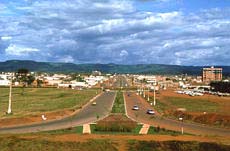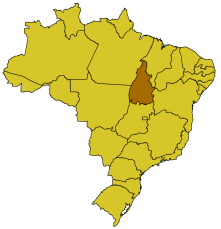Advertising by Google
Palmas, Tocantins
Area: 2474,95 km2.
Population: 187 639 inhab. (est. 2004)
Check out map of Tocantins.
The name Palmas means "palms", a reference to the palm trees which abound in the region.
Palmas, capital of the state of Tocantins, is still a building site. It is the newest city in Brazil and is known as the "capital of opportunity", attracting thousands of people who, in search of work, have migrated to this new economic frontier of the country. It is within this climate of growth that tourism is seen as a factor to be exploited. With its natural beauties still intact, kilometres of river beaches, waterfalls and ecological reserves, the capital is located in the geographical centre of Tocantins and forms part of the Palmas Tourist Region, together with four other municipalities - Lajeado, Miracema do Tocantins, Monte do Carmo and Porto Nacional.
 One of the main attractions in the Palmas area is Graciosa beach, on the banks of the Tocantins river, which draws up to 15,000 people a weekend during the "Tocantins summer", from July to September. Also near the capital is the Serra da Figura, a hill which can be climbed on foot. On the top there are many prehistoric inscriptions and representations of human figures, domestic objects, animals etc.
One of the main attractions in the Palmas area is Graciosa beach, on the banks of the Tocantins river, which draws up to 15,000 people a weekend during the "Tocantins summer", from July to September. Also near the capital is the Serra da Figura, a hill which can be climbed on foot. On the top there are many prehistoric inscriptions and representations of human figures, domestic objects, animals etc.
In Lajeado, there are white water rapids on the river known as Mares de Tocantins, and at Serra das Escritas there is a ten metre long panel with many forms of geometrical inscriptions, recalling the distant past of the first inhabitant of the region, prehistoric man. There is also the hill known as Morro do Segredo, shaped like a volcano, on the 250 metre summit of which, according to local people, mysterious lights as if from flying saucers can sometimes be seen. In the Serra do Lajeado there are examples of three types of vegetation - caatinga, cerrado and tropical forest - which are the natural habitats of dozens of species, some of them in danger of extinction, such as the eagle hawk, the king vulture, the tapir, the deer and the leopard.

Tocantins in Brazil
Miracema do Tocantins is economically important, especially for pineapple production, and is also an attraction for its urban river beaches. The town is also the best place to buy arts and crafts made by the Xerentes Indians.
Monte do Carmo is a pleasant town almost 250 years old. With its simple type of eighteenth century architecture and narrow streets, the town preserves some of the stories and traditions of its first inhabitants. The church of Nossa Senhora do Carmo was built in 1801, at a time when gold production in the region was in decline. Monte do Carmo also has the Suero Waterfall. Legend goes that the inhabitants of the town would regulate their crop farming and cattle raising activities by the waterfall - or rather, by the sound it made. They believed it made a roaring sound to announce when it was going to rain.
Although it has many river beaches, Porto Nacional's feature most often shown on postcards is the Cathedral of Nossa Senhora das Merces. Constructed in the nineteenth century in brick and stone, its columns and arches are inspired by the romantic style of Toulouse in France, from where its Dominican friar founders came.
Read more about Palmas:
 The Legislative House of Palmas. Information about laws being voted in Palmas.
The Legislative House of Palmas. Information about laws being voted in Palmas.
 Palmas official site. Maintained by the city government.
Palmas official site. Maintained by the city government.
 Ecologica.org.br. NGO with office in Palmas, dedicated to researches about the ecosystems of the region: cerrado, Amazon and Pantanal.
Ecologica.org.br. NGO with office in Palmas, dedicated to researches about the ecosystems of the region: cerrado, Amazon and Pantanal.
 Universidade Federal do Tocantins. The Federal University of Tocantins, campus in Palmas.
Universidade Federal do Tocantins. The Federal University of Tocantins, campus in Palmas.
 Palmas, Tocantins. Site of a Dutch group which is fomenting businesses in Palmas and other cities of the State; includes a selection of high definition photos of Palmas.
Palmas, Tocantins. Site of a Dutch group which is fomenting businesses in Palmas and other cities of the State; includes a selection of high definition photos of Palmas.
Hotels in Palmas
Pousada das Artes. Information in Portuguese and English.
Pousada dos Girassóis. Information in Portuguese, English and Spanish.
Back to Top